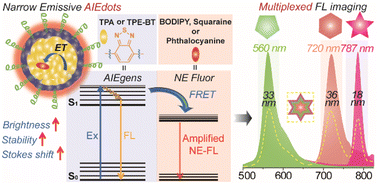Ultrabright AIEdots with tunable narrow emission for multiplexed fluorescence imaging†
Abstract
AIEgen doped fluorescent nanodots (AIEdots) have attracted lots of attention, due to their superior characteristics as fluorescent probes, such as excellent photostability, large Stokes shift, high brightness and tunable emission. Unfortunately, most of the currently available AIEdots exhibit broad emission bandwidth, which limits their applications in multiplexed fluorescence imaging and detection. In this work, the strategy of designing and fabricating narrow emissive AIEdots (NE-AIEdots) with tunable wavelengths was presented by constructing a light-harvesting system with high energy transfer efficiency. Efficient intra-particle energy transfer from highly doped AIEgens, serving as the light-harvesting antenna, to the lightly doped narrow emissive fluorophore, resulted in high brightness and narrow emission. The emission band of NE-AIEdots with the full-width-at-half-maximum varied from 18 to 36 nm was 3–6.3 times narrower than that of traditional AIEdots. The single-particle brightness of NE-AIEdots was over 5-times that of commercial quantum dots under the same excitation and collection conditions. Taking advantage of the superior performance of these NE-AIEdots, multiplexed fluorescence imaging of lymph nodes in living mice was realized, which supported the future applications of NE-AIEdots for in vivo multiplexed labeling and clinical surgery.



 Please wait while we load your content...
Please wait while we load your content...